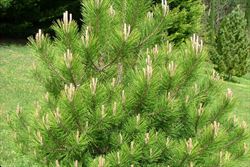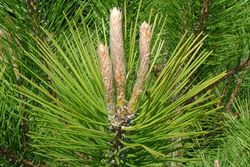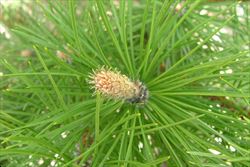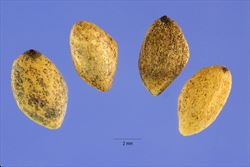Click on images to enlarge

habit (Photo: Sheldon Navie)

branches with leaves and young growth (Photo: Sheldon Navie)

the elongated needle-like leaves, which are grouped in pairs and surrounded by a sheath at their bases, and young shoots (Photo: Sheldon Navie)

close-up of leaves and growing point (Photo: Sheldon Navie)

close-up of seeds after their wings have been removed (Photo: Steve Hurst at USDA PLANTS Database)
Scientific Name
Pinus nigra J. F. Arnold subsp. laricio Maire
Synonyms
Pinus laricio Poir. var. corsicana LoudonPinus nigra J. F. ArnoldPinus nigra J. F. Arnold var. corsicana (Loudon) Hyl.Pinus nigra J. F. Arnold var. maritima (Aiton) MelvillePinus sylvestris L. var. maritima Aiton
Family
Pinaceae
Common Names
black pine, Calabrian black pine, Corsican pine
Origin
Native to southern Europe (i.e. Corsica, Sicily, and the province of Calabria in Italy).
Naturalised Distribution
Occasionally naturalised in south-eastern Austrlia (i.e. in southern Victoria and south-eastern South Australia).
Naturalised overseas in the UK and New Zealand.
Note: Corsican pine (Pinus nigra subsp. laricio) was also incorrectly thought to have become naturalised in some parts of southern New South Wales. However, all of these records are now regarded to represent populations of Aleppo pine (Pinus halepensis).
Notes
Corsican pine (Pinus nigra subsp. laricio) is regarded as an environmental weed in Victoria and South Australia, and is a potential environmental weed in other parts of southern Australia. This species has been cultivated as an ornamental and in forestry plantations in temperate regions. It has spread from these plantings and is invading nearby natural vegetation, like other invasive pine trees.
Corsican pine (Pinus nigra subsp. laricio) is ranked as a high impact species in the Angahook-Otways region in Victoria, because it has the ability to cause disruption to ecological processes, dominate vegetation strata, cause severe loss of biodiversity, and reduce the regeneration opportunities of native plants.

